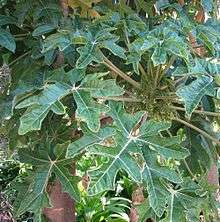Mountain papaya
The mountain papaya (Vasconcellea pubescens) also known as mountain pawpaw, papayuelo, chamburo, or simply "papaya" is a species of the genus Vasconcellea, native to the Andes of northwestern South America from Colombia south to central Chile, typically growing at altitudes of 1,500–3,000 metres (4,900–9,800 ft).
| Look up mountain papaya in Wiktionary, the free dictionary. |
| Mountain papaya | |
|---|---|
.jpg) | |
| Scientific classification | |
| Kingdom: | Plantae |
| Clade: | Tracheophytes |
| Clade: | Angiosperms |
| Clade: | Eudicots |
| Clade: | Rosids |
| Order: | Brassicales |
| Family: | Caricaceae |
| Genus: | Vasconcellea |
| Species: | V. pubescens |
| Binomial name | |
| Vasconcellea pubescens | |
| Synonyms | |
| |
| Wikimedia Commons has media related to Vasconcellea pubescens. |
It has also been known as Carica pubescens.
Description
Vasconcellea pubescens is an evergreen pachycaul shrub or small tree growing to 10 metres (33 ft) tall.
%2Cfr(wh%2CTS)_Naivasha-Gilgil(Rift_Valley_Prov.)%2CKE_tue13sep2011-1230h.jpg)
The fruit is 6–15 cm long and 3–8 cm broad, with five broad longitudinal ribs from base to apex; it is green, maturing yellow to orange. The fruit pulp is edible, similar to papaya, and is usually cooked as a vegetable. It is also eaten raw.

Cultivation
Vasconcellea pubescens is one of the parents of the 'Babaco' papaya, a hybrid cultivar widely grown for fruit production in South America, and in subtropical portions of North America.
References
- "Vasconcellea pubescens A.DC. — The Plant List". www.theplantlist.org.